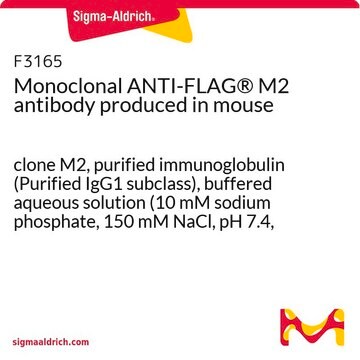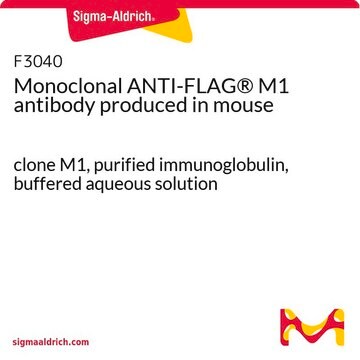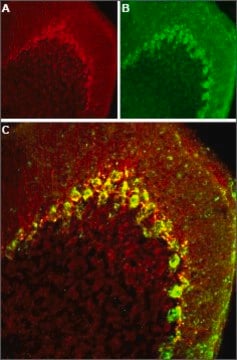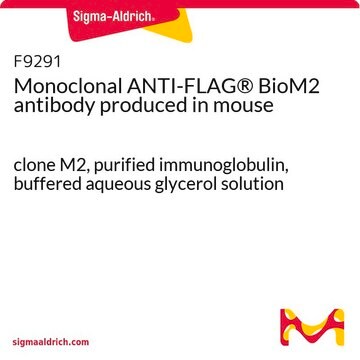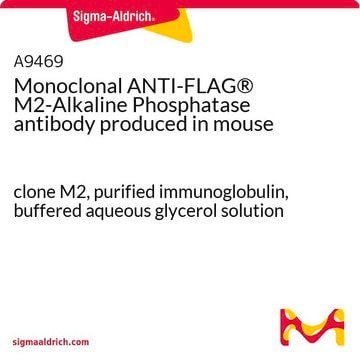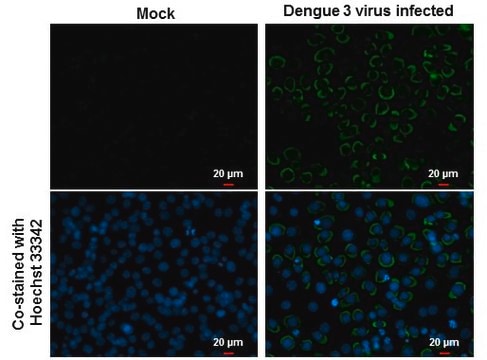추천 제품
생물학적 소스
rat
결합
unconjugated
항체 형태
purified from hybridoma cell culture
purified immunoglobulin
항체 생산 유형
primary antibodies
클론
6F7, monoclonal
양식
buffered aqueous solution
종 반응성
all
기술
immunoprecipitation (IP): 2.5-5.0 μg using lysates of transiently transfected cells expressing C-terminal-FLAG-tagged protein
western blot: 0.5-1.0 μg/mL using extracts of transiently transfected cells expressing C-terminal-FLAG-tagged protein
동형
IgG1
면역원 서열
(DYKDDDDK)
배송 상태
dry ice
저장 온도
−20°C
1 of 4
이 품목 | F7425 | SAB4200119 | F2555 |
|---|---|---|---|
| species reactivity all | species reactivity all | species reactivity all | species reactivity - |
| conjugate unconjugated | conjugate unconjugated | conjugate peroxidase conjugate | conjugate unconjugated |
| antibody form purified from hybridoma cell culture, purified immunoglobulin | antibody form affinity isolated antibody | antibody form purified immunoglobulin | antibody form ascites fluid |
| clone 6F7, monoclonal | clone polyclonal | clone 6F7, monoclonal | clone SIG1-25, monoclonal |
| biological source rat | biological source rabbit | biological source rat | biological source rabbit |
| storage temp. −20°C | storage temp. −20°C | storage temp. −20°C | storage temp. −20°C |
일반 설명
Monoclonal Anti-FLAG® recognizes N-terminal,
C-terminal and internal Flag-tagged fusion proteins. The product is especially recommended for identifying C-terminal FLAG®-tagged fusion proteins.
Epitope tags provide a method to localize gene products in a variety of cell types, study the topology of proteins and protein complexes, identify associated proteins, and characterize newly identified, low abundance, or poorly immunogenic proteins when protein specific antibodies are not available. Tagging with the FLAG® peptide sequence may be done at the N-terminus, N-terminus preceded by a methionine residue, C-terminus, or at internal positions of the target protein. FLAG may also be placed in associationith other tags.[1] The small size of the FLAG® tag or sequence and its high hydrophilicity tend to decrease the possibility of interference with the protein expression, proteolytic maturation, antigenicity, and function.
The N-terminal FLAG® peptide sequence contains a unique enterokinase cleavage site allowing it to be completely removed from the purified fusion proteins. Cleavage of the C-terminal FLAG® peptide from a fusion protein catalyzed by Cu2+ ions has been reported.[2] A sequence motif with five out of eight amino acid residues identical to the FLAG peptide is found in both rat and mouse Mg2+dependent protein b-phosphatase[3], as well as in the human and bovine enzyme.
면역원
DYKDDDDK
애플리케이션
- chromatin immunoprecipitation (ChIP)[4]
- western blotting[5]
- coimmunoprecipitation[6][7]
- flow cytometric analysis[7]
물리적 형태
법적 정보
적합한 제품을 찾을 수 없으신가요?
당사의 제품 선택기 도구.을(를) 시도해 보세요.
Storage Class Code
10 - Combustible liquids
Flash Point (°F)
Not applicable
Flash Point (°C)
Not applicable
가장 최신 버전 중 하나를 선택하세요:
시험 성적서(COA)
이미 열람한 고객
활성 필터
자사의 과학자팀은 생명 과학, 재료 과학, 화학 합성, 크로마토그래피, 분석 및 기타 많은 영역을 포함한 모든 과학 분야에 경험이 있습니다..
고객지원팀으로 연락바랍니다.